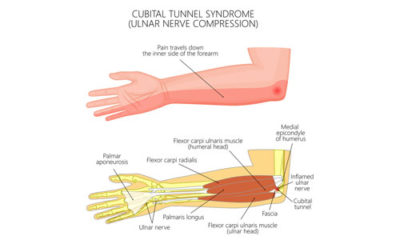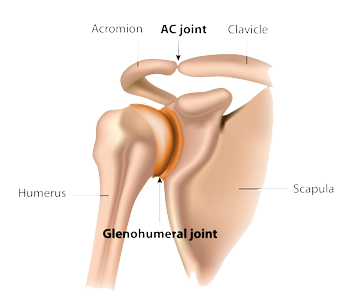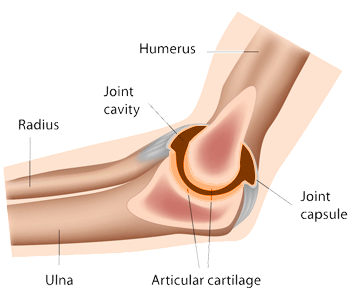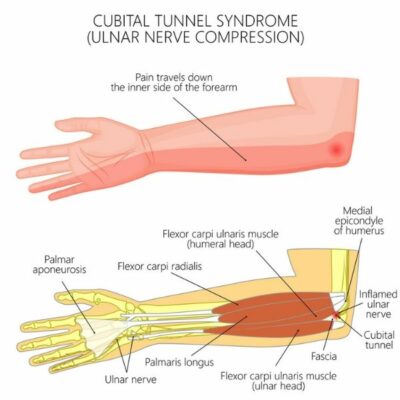Ulnar Nerve Entrapment Specialists

Are you experiencing pain, numbness, tingling and a “falling asleep” sensation in the little finger and ring finger? If so, you may have ulnar nerve entrapment. Ulnar nerve entrapment can occur in several places along the nerve path, most commonly on the inside of the elbow. It is very important to visit a doctor at the onset of ulnar nerve compression symptoms to avoid muscle wasting. The ulnar nerve entrapment specialists at Shoulder Clinic of Idaho provide diagnosis and both surgical and nonsurgical treatment options for patients in Boise who are experiencing ulnar nerve entrapment. Contact the Shoulder Clinic of Idaho team today!
What is ulnar nerve entrapment?
Three main nerves travel up and down the arm sending signals from the brain to the arm, hand and fingers. The ulnar nerve is one of these message carriers that travel from the neck, near the collarbone, through the inside of the upper arm, and through the elbow joint as it courses to the wrist. The ulnar nerve travels through the forearm into the hand and ends near the little and ring fingers. This nerve controls sensation to the little finger and the ring finger, and also controls the fine coordinated movements of the hand.
Ulnar nerve entrapment, also called cubital tunnel syndrome, occurs when the ulnar nerve becomes compressed or entrapped along its path. Entrapment happens most commonly on the inside of the elbow, as the nerve passes behind the medial epicondyle, a bony protuberance, on the inside of the elbow. The location which the ulnar nerve travels behind the medial epicondyle is called the cubital tunnel. The ulnar nerve’s location is posterior to the access of flexion of the elbow as it passes behind the medial epicondyle. As a consequence of this location, the nerve is stretched and compressed as the elbow is brought into greater degrees of flexion. Ulnar nerve entrapment can cause numbness and tingling in the hand and fingers. It can also send shocks of pain and tingling to the little finger and ring finger if accidently struck in this location, and is responsible for the nickname “funny bone.” Severe cubital tunnel syndrome will not only cause numbness of the little and ring finger of the hand, but it can also result in a loss of fine motor skills of the hand. Many patients report their hand feels “clumsy” and many patients will report inadvertently dropping things along with a loss of hand dexterity. The orthopedic specialists at The Shoulder Clinic of Idaho serving Boise, Meridian, Nampa and the surrounding communities of the Treasure Valley have extensive experience in treating ulnar nerve entrapment with modern and conservative methods.
What causes ulnar nerve entrapment?
 The ulnar nerve is vulnerable to compression at the elbow because it must travel through a narrow space with very little soft tissue that gives it protection behind the access of elbow flexion. Because of this, many patients will experience symptoms at night, particularly if they sleep with their elbows flexed or clutched close to their body. One of the more common and effective treatments of early cubital tunnel syndrome is night splinting where the elbow is purposely held in extension by a small brace. There are a few contributing factors which may also contribute to the development of ulnar nerve entrapment:
The ulnar nerve is vulnerable to compression at the elbow because it must travel through a narrow space with very little soft tissue that gives it protection behind the access of elbow flexion. Because of this, many patients will experience symptoms at night, particularly if they sleep with their elbows flexed or clutched close to their body. One of the more common and effective treatments of early cubital tunnel syndrome is night splinting where the elbow is purposely held in extension by a small brace. There are a few contributing factors which may also contribute to the development of ulnar nerve entrapment:
- Prior elbow conditions or injuries such as fractures, cysts or bone spurs.
- Intense physical activity which puts pressure on the ulnar nerve; i.e. baseball pitchers.
- Fluid build-up causing swelling and the narrowing of space through which the nerve travels.
- A direct blow to the inside of the elbow can cause pain or an electric shock sensation called “hitting your funny bone.” Repeated injury of this nature can cause compression of the nerve.
- Prolonged pressure placed on the ulnar nerve – such as driving with the elbow braced on the window or arm rest.
- In some patients, the ulnar nerve slides out from behind the medial epicondyle (inside bump of the elbow) when the elbow is bent. Over time, this sliding back and forth may irritate the ulnar nerve.
- Leaning on the elbow, or sleeping on a bent elbow for prolonged periods of time can compress the ulnar nerve.
- Genetic history of nerve compression syndromes, obesity, and diabetes may also contribute to the development of cubital tunnel syndrome.
What are the symptoms of cubital tunnel syndrome?
Symptoms of ulnar nerve entrapment may develop gradually. Early symptoms include numbness and tingling in the little finger and ring finger, as well as pain located near the inside of the elbow. More severe symptoms include:
- Weakness affecting the fingers of the hand
- Clumsiness of the hand and frequently dropping things
- Symptoms that worsen at night
- Pain or a burning sensation in the elbow, palm or last two fingers
- Loss of finger dexterity and coordination
With severe symptoms, it is important to see an orthopedic specialist at The Shoulder Clinic of Idaho. It is important to have cubital tunnel syndrome treated promptly for a good outcome, once muscle wasting has begun, it cannot be reversed.
How is ulnar nerve entrapment diagnosed?
Patients in Boise, Meridian, Nampa and the surrounding communities of the Treasure Valley should expect to be evaluated by an orthopedic specialist so that a thorough medical history can be obtained. The orthopedic surgeon will conduct a physical exam of the affected arm, elbow and hand. They may tap on the nerve at the funny bone, check for strength and feeling in the hands and fingers and check to see if the ulnar nerve slides out of place when the elbow is bent.
Additional testing may include a diagnostic test called an electromyogram (EMG). This nerve conduction test is used to find out how fast a signal travels down a nerve and to discover where the nerve may be compressed. It may also determine if muscle weakness is present which may indicate a more severe or advanced cubital tunnel syndrome as a result of prolonged and or severe compression on the ulnar nerve.
How is ulnar nerve entrapment treated?
Non-surgical Treatment:
For most patients, a non-surgical approach is recommended as the first treatment option. Physical and occupational therapy may help strengthen the muscles and tendons located in the elbow and hands. If pain is severe, anti-inflammatory medication may be suggested to reduce inflammation, leading to a reduction in pain. For some patients, a splint may help “rest” the injury, leading to quicker healing by immobilizing the joint, particularly when used at night.
Surgical Treatment:
In patients where cubital tunnel syndrome is severe, or in cases of muscle weakness when non-surgical measures have failed to alleviate the symptoms, surgery may be recommended. An incision at the elbow allows the nerve to be decompressed by removing pressure from surrounding tissue. In some cases the nerve may be moved to a location in front of the medial epicondyle so that it is no longer posterior to the access of elbow flexion. This helps take additional pressure off of the nerve and is required in some cases. During this specialized minimally invasive procedure, the nerve is allowed to work more normally hopefully offering a return of normal function. At a minimum, it prevents the sensation and motor function from getting any worse. To discuss which treatment alternative is right for you, seek the advice of a orthopedic specialist who specializes in shoulder and elbow problems like the orthopedic specialists at The Shoulder Clinic of Idaho.
If you are experiencing pain in the elbow or numbness and tingling in the little fingers or hand and would like to be evaluated for ulnar nerve entrapment, please contact the orthopedic elbow specialists at The Shoulder Clinic of Idaho serving patients in Boise, Meridian, Nampa and the surrounding communities of the Treasure Valley.



